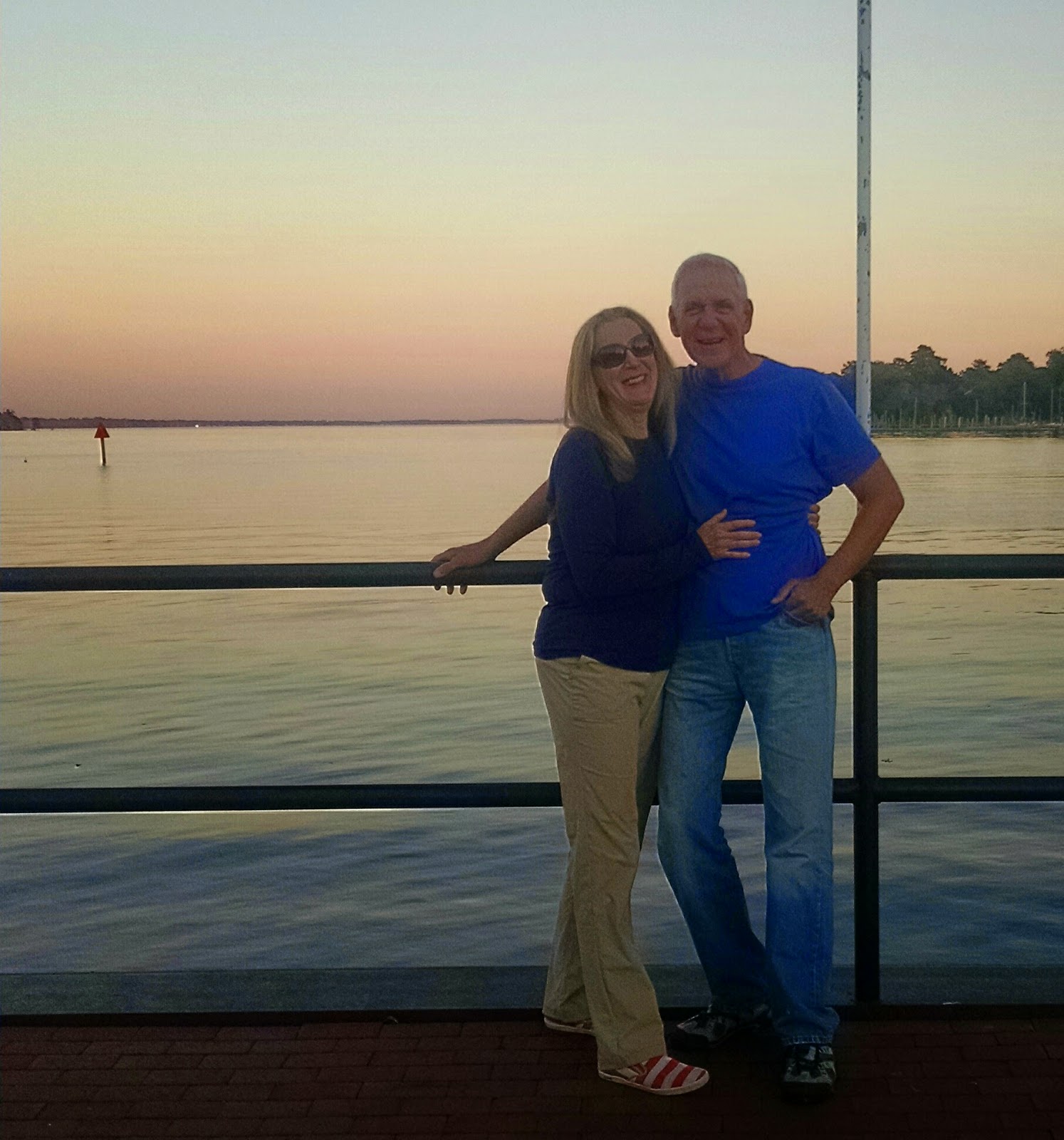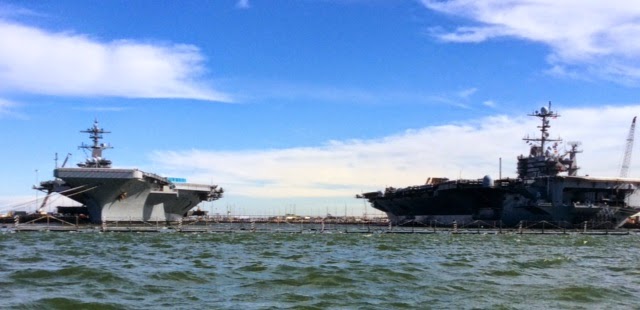From Eliz. City we got a late, 11 A.M. start, due to marketing. It was mostly motoring but we put up the genoa three times for
about half of the passage, once even turning off the motor. We arrived at the anchorage after the sun had set, but
before it got dark. Our route was to continue down the Pasquotank River, traverse Albemarle Sound and go south (up) the Alligator River to a place off Deep Point
which is deep enough to anchor, moderately protected from potential winds,
outside the ICW channel and reachable before dark. The little white space to the left of the word "River" in the upper right quadrant of this chart segment hit the spot. It is 2/3 of a mile long and about 700 feet wide at its widest spot.
There are about 8 boats here. We are in 11 feet of water with 60 feet of chain out. We have a potential problem because when we tried to use reverse gear to set the anchor, we heard only strange sounds. So we laid out sixty feet of chain, which, with the weight of the anchor, held us in place all night in very gentle air. If we had dragged, there was a lot of room behind us toward the channel in which the anchor, hopefully would have caught. No internet access here. Dinner, card games (Lene almost always wins), reading and in the morning we emptied the aft compartment so I could take a look at the "no reverse gear" problem. I saw how, by disconnecting the end of the cable from the shift lever at the helm, one could manually shift the boat at the engine itself. And while we had access, I added distilled water to those of the cells of the batteries that looked like they could use a few sips.
Among the boats here were "Whisper," who we met in Elizabeth City, and their buddy boat "Piper."
In fact, two of the three adorable kids who played with Witty belong to Piper, not Whisper. We accompanied them most of the next day, toward Slade Creek through the Alligator-Pungo Canal and somewhat down the Pungo River, but they had elected to go elsewhere the second day.
The AP canal is quite a bit wider and almost twice as deep as the Great Dismal Swamp Canal.
Our only scary moment was crossing under the Wilkerson Bridge, near its southern end; unlike all the other fixed bridges over the ICW, which are 65 feet high, this one got short changed and is only 64 feet high -- and we are 63.5 feet high!
Slade Creek is wide and over a mile long. We got here first, at about 2:30 after a totally motoring day, and anchored in the first bend after entry, where the wind protection was good, in eight feet of water and were later joined by two other boats. There is lots of room here.
Then chores: I dove into the brownish, tannin dyed water and cut several lengths of line from around our propeller, but the boat still makes a chattering noise in reverse. We will get this checked out in Oriental, our next stop. (Also the harvesting of leaves in the Great Dismal Swamp Canal whacked our wind speed and direction instruments making them even more in need of calibration.) I went up the mast to reattach the halyard for the Harlem Yacht Club burgee because the halyard had worn through in the strong winds in Yorktown, completed the wiring of our two million candlepower flashlight for finding buoys at night, hung a picture, fixed a cabinet and organized our cabinets. This last in the course of looking for the two white LED interior lights that we replaced with red ones to preserve night vision. Lene does not like living in a red light district. But we have not found the white ones yet.
The problem here is flies, lots of them. Lene killed about a hundred that had invaded ILENE. She is fully screened but they got in while we were underway and the companionway was open.
Also Alphie gave Lene a scare. She was missing, Lene was crying. I looked in both the aft end and the forward end of the stack pack tube that holds our mainsail when it is not in use. No Alphie. Finally I unzipped the top of the tube to raise this sail and there she was, in the middle, perturbed that her nap disturbed.
There are about 8 boats here. We are in 11 feet of water with 60 feet of chain out. We have a potential problem because when we tried to use reverse gear to set the anchor, we heard only strange sounds. So we laid out sixty feet of chain, which, with the weight of the anchor, held us in place all night in very gentle air. If we had dragged, there was a lot of room behind us toward the channel in which the anchor, hopefully would have caught. No internet access here. Dinner, card games (Lene almost always wins), reading and in the morning we emptied the aft compartment so I could take a look at the "no reverse gear" problem. I saw how, by disconnecting the end of the cable from the shift lever at the helm, one could manually shift the boat at the engine itself. And while we had access, I added distilled water to those of the cells of the batteries that looked like they could use a few sips.
Among the boats here were "Whisper," who we met in Elizabeth City, and their buddy boat "Piper."
In fact, two of the three adorable kids who played with Witty belong to Piper, not Whisper. We accompanied them most of the next day, toward Slade Creek through the Alligator-Pungo Canal and somewhat down the Pungo River, but they had elected to go elsewhere the second day.
The AP canal is quite a bit wider and almost twice as deep as the Great Dismal Swamp Canal.
Our only scary moment was crossing under the Wilkerson Bridge, near its southern end; unlike all the other fixed bridges over the ICW, which are 65 feet high, this one got short changed and is only 64 feet high -- and we are 63.5 feet high!
Slade Creek is wide and over a mile long. We got here first, at about 2:30 after a totally motoring day, and anchored in the first bend after entry, where the wind protection was good, in eight feet of water and were later joined by two other boats. There is lots of room here.
Then chores: I dove into the brownish, tannin dyed water and cut several lengths of line from around our propeller, but the boat still makes a chattering noise in reverse. We will get this checked out in Oriental, our next stop. (Also the harvesting of leaves in the Great Dismal Swamp Canal whacked our wind speed and direction instruments making them even more in need of calibration.) I went up the mast to reattach the halyard for the Harlem Yacht Club burgee because the halyard had worn through in the strong winds in Yorktown, completed the wiring of our two million candlepower flashlight for finding buoys at night, hung a picture, fixed a cabinet and organized our cabinets. This last in the course of looking for the two white LED interior lights that we replaced with red ones to preserve night vision. Lene does not like living in a red light district. But we have not found the white ones yet.
The problem here is flies, lots of them. Lene killed about a hundred that had invaded ILENE. She is fully screened but they got in while we were underway and the companionway was open.
Also Alphie gave Lene a scare. She was missing, Lene was crying. I looked in both the aft end and the forward end of the stack pack tube that holds our mainsail when it is not in use. No Alphie. Finally I unzipped the top of the tube to raise this sail and there she was, in the middle, perturbed that her nap disturbed.




































 J
J











